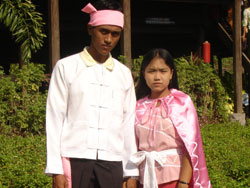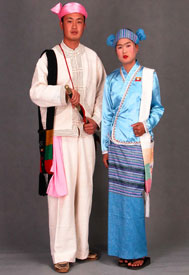
It is commonly known that 135 ethnic groups reside in different parts of Myanmar. Different topographical feature had separated the ethnic tribes and they became totally exclusive from the mainland Myanmar. Finally, this diversity is rendering the major attraction to those travelers who are keen to see these minorities living in the hidden area. Myanmar is composed of rich in natural resources, beautiful scenery, and most of all, with exotic people with their remarkable traditions. The ethnic groups and people with various traits and customs living in great harmony. it is a peaceful land where races and cultures are relative rather than absolute. The main people of Myanmar are called Myanmar or Bamar.
There are 8 main nationalities of Myanmar. They are:
- Kachin, the original name of the race known as Kachin is Jinghpaw, Jinghpaw is the racial name for the tribes known as the Hkahkus, Gauris, Lashis, Marus, Atsis and Nungs as well as for the Jinghpaw proper.
- Kayah, Kayah State is inhabited by Kayah, Kayan or (Padaung) Mono, Kayaw, Yintalei, Gekho, Hheba, Shan, Intha, Bamar, Rakhine, Chin, Kachin, Kayin, Mon and Pao. Kayah State
- Kayin, the Kayin hill tribe villages are mainly concentrated in the mountains and also along the Myanmar-Thai border in the Kayin State.
- Chin, Chin is one of the ethnic groups in Myanmar. The Chins are found mainly in western part of Myanmar in the Chin State and about a population of 1.5 million. They also live in nearby Indian states of Nagaland, Mizoram and Manipur and Assam.
- Bamar are inhabitants of the Ayeyarwaddy river valley, representing a large percent of the country's population.
- Mon, the Mons are the principal Burma branch of the Mon-Khmer. Mon Burmar, Pao , Rakhine, Chin, Kachin, Shan and Kayin inhabit the Mon state. In 1983 the population was about 1637,200 and in 1996 the population was 2.4 million. Majority of the inhabitant are Mons and Bamars.
- Rakhine, rakhines reside in western Rakhine coast, they are closely related to Burmese proper, though their form of Burmese language varies from the language of the Ayeyawady Valley
- Shan, shans reside in the Eastern plateau. The Shan State of Myanmar occupy principally the plateau east of the Ayeyawady and Sittaung valleys, south of the Bhamo district and north of Kayah State.Shan are settling in valleys and river basins.
We have 71 guests and no members online
86. Bamar (Burman)
87. Dawei of Dawei city
88. Beik
89. Yaw
90. Yabein
91. Kadu (Kado)
92. Ganan
93. Salone (Salon; Moken)
94. Hpon
Pa-O people are mostly live in shan state (south). Hopong. Taunggyi. Pinloung. Nyaung Shwe. Mountmei and Mong Kai.
Danu people are mostly live in shan state(south). Pintaya. Aungban. Ywangan. Kalaw and Naungcho.
Taungyo people are mostly live in shan state(south). Taunggyi. Kalaw(Heho). Yetsouth and Nyaung Shwe.
Intha people are mostly live in shan state (south) Nyaung Shwe and around Inle Lake.
Tai-Li people are mostly live in shan state(east). Kyaing Tong. Mongyawng and Monglar.
Pale people are mostly live in shan state(south). Kalaw. shan state(north) NamSan. Namkham. Manton. Tanyang and Mongye.
Around AD 1000. women clothes of the Pyu era. were made from silk and cotton.During the Bagan period. embroidered shawl is worn over the shoulders as a popularity. They also had bands around their arms.During the Yadanar Bon period. a Htai Ma Thein Jacket is worn with Anoh. Emerald shawl is wrapped over the shoulder (Dae wi wrap) or queen's style of wearing shawl.
Tai-Nay people are mostly live in shan state(north). Muse. NamKham and Khonlon Township.
Tai-Loi people are mostly live in shan state(east). Kyaing Tong. MongLar and Mongpyinn.
Kayaw Kayah people are mostly live in Loikaw. Demoso. Hpruso. Bawlakhe and Hpasawng township.
Tai-Sar people are mostly live in shan state(south). Moenae and Mongpan.
Kayan (Lahta) Kayah people are mostly live in Loikaw. Demoso and Hpruso.
Manumanaw Kayah people are mostly live in Demoso. Hpruso and Bawlakhe Township.
Kayah State is inhabited by Kayah. Kayan or (Padaung) Mono. Kayaw. Yintalei. Gekho. Hheba. Shan. Intha. Bamar. Rakhine. Chin. Kachin.Kayin . Mon and Pao . Kayah State had a population of 158.400 in 1983 and in1996 the estimated population is over 240.000. Kayah State is situated in eastern Myanmar and bounded on the north by Shan State and on the east by Thailand and on the south and west by Kayin state. 49 per cent of the population are are Buddhists. 43 per cent are Christians and 6 per cent are Animists.
The Kayin hill tribe villages are mainly concentrated in the mountains and also along the Myanmar-Thai border in the Kayin State.The Kayin people like to settle in the foothills. living in bamboo houses raised on stilts. beneath which they keep their live domestic animals: pigs. chickens. and buffaloes.The Kayin practice monogamy and look down on pre-marital sex with strict social community laws against immorality. Two married women cannot live in the same house. In the past. in some villages. punishment for adultery was death.
The Naga people of about two and half million are found in Nagaland. parts of Manipur. Assam. Arunachal Pradesh and Myanmar. Of mixed Yunnanese and Myanmar origin. they speak tribal dialects belonging to the Tibeto-Burman familyIn Myanmar they live in the borders of Sagaing Dviision and Chin States bordering India to the west.
The Mons are the principal Burma branch of the Mon-Khmer. Mon Burmar. Pao . Rakhine. Chin. Kachin. Shan and Kayin inhabit the Mon state. In 1983 the population was about 1637.200 and in 1996 the population was 2.4 million. Majority of the inhabitant are Mons and Bamars.
Hkun people are mostly live in Shan state(East). Kyaingtong Township. Mong Pyin Township. Mongphyat Township.Mong Yawng Township. Mong Hsat Township. Tachileik Township.
Rakhines reside in western Rakhine coast. they are closely related to Burmese proper. though their form of Burmese language varies from the language of the Ayeyawady Valley. notably in the retention of the 'R'sound which in Burmese proper has been replaced by 'Y'.
Lahu people are mostly live in Shan state(east). Kyaing Ton Township. Mong Hsat Township. Mongphyat Township. Mong Yang Township. Mong Tong Township. Mong Pyin Township. Tachileik Township. Lashio Township. Mong Khet Township.
Shans reside in the Eastern plateau. The Shan State of Myanmar occupy principally the plateau east of the Ayeyawady and Sittaung valleys. south of the Bhamo district and north of Kayah State.Shan are settling in valleys and river basins. Most of the Danu. Taungyoe. Intha (Ansa). and Bamar are living in the western part of the Shan State. A lot of Palaung. Click here to view a showcase by Shan State government.
Tai-Lem people are mostly live in shan state (east). Kyaing Tong township. Mong Khet township and Mong Yang township.
































